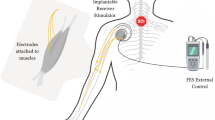Summary
The possibility that nitric oxide is somehow involved in the early bioelectrical disturbances following spinal cord injury in relation to the later pathophysiology of the spinal cord was examined in a rat model of spinal cord trauma. A focal trauma to the rat spinal cord was produced by an incision of the right dorsal horn of the T 10–11 segments under urethane anaesthesia. The spinal cord evoked potentials (SCEP) were recorded using epidural electrodes placed over the T9 and T12 segments of the cord following supramaximal stimulation of the right tibial and sural nerves in the hind leg. Trauma to the spinal cord significantly attenuated the SCEP amplitude (about 60%) immediately after injury which persisted up to 1h. However, a significant increase in SCEP latency was seen at the end of 5h after trauma. These spinal cord segments exhibited profound upregulation of neuronal nitric oxide synthase (NOS) immunoreactivity, and the development of edema and cell injury. Pretreatment with a serotonin synthesis inhibitor drug p-chlorophenylalanine (p-CPA) or an anxiolytic drug diazepam significantly attenuated the decrease in SCEP amplitude, upregulation of NOS, edema and cell injury. On the other hand, no significant reduction in SCEP amplitude, NOS immunolabelling, edema or cell changes were seen after injury in rats pretreated with L-NAME. These observations suggest that nitric oxide is somehow involved in the early disturbances of SCEP and contribute to the later pathophysiology of spinal cord injury.
Similar content being viewed by others
References
Dawson VL, Dawson TM (1996) Nitric oxide neurotoxicity. J Chem Neuroanat 10: 179–190
Schwab ME, Bartholdi D (1996) Degeneration and regeneration of axons in the lesioned spinal cord. Physiol Rev 76: 319–370
Sharma HS, Winkler T, Stålberg E, Olsson Y, Dey PK (1991) Evaluation of traumatic spinal cord edema using evoked potentials recorded from the spinal epidural space. An experimental study in the rat. J Neurol Sci 102: 150–162
Sharma HS, Olsson Y, Nyberg F, Dey PK (1993) Prostaglandins modulate alterations of microvascular permeability, blood flow, edema and serotonin levels following spinal cord injury. An experimental study in the rat. Neuroscience 57: 443–449
Sharma HS, Olsson Y, Westman J (1995) A serotonin synthesis inhibitor, p-chlorophenylalanine reduces the heat shock protein response following trauma to the spinal cord. An immunohistochemical and ultrastructural study in the rat. Neurosci Res 21: 241–249
Sharma HS, Westman J, Olsson Y, Alm P (1996) Involvement of nitric oxide in acute spinal cord injury: an immunocytochemical study using light and electron microscopy in the rat. Neurosci Res 24: 373–384
Stålberg E, Sharma HS, Olsson Y (1998) Spinal cord monitoring. Basic and clinical aspect. Springer, Wien New York (in press)
Tator CH (1995) The relationship among the severity of spinal cord injury, residual neurological function, axon counts, and counts of retrogradely labelled neurons after experimental spinal cord injury. Exp Neurol 132: 220–228
Winkler T (1994) Evaluation of spinal cord injuries using spinal cord evoked potentials. An experimental study in the rat. Acta Univ Ups 467: 1–45
Winkler T, Sharma HS, Stålberg E, Olsson Y (1993) Indomethacin, an inhibitor of prostaglandin synthesis attenuates alteration in spinal cord evoked potentials and edema formation after trauma to the spinal cord. An experimental study in the rat. Neuroscience 52: 1057–1067
Winkler T, Sharma HS, Stålberg E, Olsson Y, Nyberg F (1994) Opioid receptors influence spinal cord electrical activity and edema formation following spinal cord injury: experimental observations using naloxone in the rat. Neurosci Res 21: 91–101
Winkler T, Sharma HS, Stålberg E, Olsson Y, Dey PK (1995) Impairment of blood-brain barrier function by serotonin induces desynchronisation of spontaneous cerebral cortical activity. Experimental observations in the anaesthetised rat. Neuroscience 68: 1097–1104
Winkler T, Sharma HS, Stålberg E, Westman J (1997a) Benzodiazepine receptors influence spinal cord evoked potentials and edema following trauma to the rat spinal cord. Acta Neurochir [Suppl] 70: 216–219
Winkler T, Sharma HS, Stålberg E, Westman J (1997b) Spinal cord bioelectrical activity, edema and cell injury: a pharmacotherapeutic approach. In: Stålberg E, Sharma HS, Olsson Y (eds) Spinal cord monitoring. Basic and clinical aspects. Springer, Wien New York (in press)
Yamada K, Emson P, Hökfelt T (1996) Immunohistochemical mapping of nitric oxide synthase in the rat hypothalamus and colocalization with neuropeptides. J Chem Neuroanat 10: 295–316
Author information
Authors and Affiliations
Rights and permissions
About this article
Cite this article
Winkler, T., Sharma, H.S., Stålberg, E. et al. Spinal cord evoked potentials and edema in the pathophysiology of rat spinal cord injury. Amino Acids 14, 131–139 (1998). https://doi.org/10.1007/BF01345253
Received:
Accepted:
Issue Date:
DOI: https://doi.org/10.1007/BF01345253




